“Sadly, there are two young eagles, whose wings will never touch the sky, heal our hearts, lift our souls, or carry our prayers to God.” Martin Tyner
While we were in Utah, my friends and I had a special opportunity to spend time with Martin Tyner, a licensed wildlife rehabilitator and educator (July article: Death Valley & Utah…A Memorable Trip). Through his non-profit Southwest Wildlife Foundation (www.gowildlife.org), he cares for sick, injured, and orphaned wildlife native to Utah. Restoring them to health so they can be returned to the wild is his primary goal. For those creatures that can’t be released because of their disabilities, a new Nature Center (now in the planning stage, but hopefully a reality soon) will provide them with a permanent home in a natural setting. It will also enhance the educational experience of anyone visiting the park near Cedar City, Utah. The story I‘m about to tell is one of joy and, unfortunately, great tragedy. It does have a partially happy ending – but I’m getting ahead of myself.
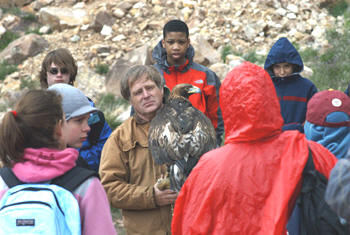
Copyright 2007 Stan Westfall
Martin is showing a school group from the Washington, DC area the Golden Eagle he uses in his educational programs.
My friends and I met Martin as he was sharing some local sights with a school group from Washington, DC. He was pointing out several beautiful petroglyphs as well as the footprints of a baby dinosaur and a large dinosaur. The highlight of the visit came when Martin brought out birds that he has been working with in his educational programs. The children could move close enough to really examine a Harris hawk named Thumper and a magnificent golden eagle named Scout. Neither of these birds was able to be released back into the wild, but they were perfectly suited for the educational programs. Although the children seemed to have a million questions, Martin answered each one. He explained, “You won’t hurt what you know and admire.”
After the school group left, Martin kindly spent time wandering with us. We drove around back roads for a bit before he had us walk up a steep hill to observe the nest of a golden eagle. It was unusual, because we could see three small baby eaglets inside. Three babies in an eagle’s nest are very, very rare. In most years, only two eggs will be laid, and—if food is abundant–both may survive.
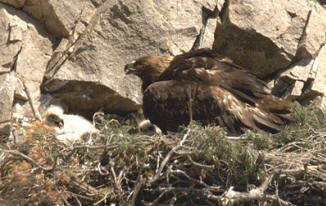
Copyright 2007 Anne Westfall
The eaglets are being shielded from the sun by the adult eagle. The Golden Eagle hunts mainly squirrels and rabbits. Babies eat as much or more than the parent as they are growing.
If food is scarce, one baby dies. Baby eaglets eat almost as much or more than the adult parents, and it’s a lot of work for Mom and Dad to find enough food to feed themselves in addition to offspring. Three thriving eaglets are really unusual. I don’t think I can adequately describe the thrill of seeing Mom shielding her young from the sun while one of the fuzzy babies stood up on wobbly legs, wings that had no feathers yet.
Over the few weeks of our visit, we stayed in contact with Martin and learned that the babies were growing and developing feathers. After a few weeks more, their feathers had all come in. The little ones were beginning to look like eagles. Their activities in the nest included flapping and hopping in preparation for their first flight.
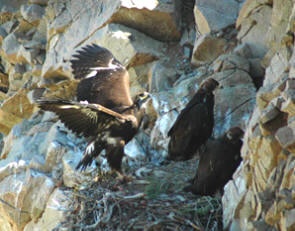
Copyright 2007 Martin Tyner
Jumping and wing flapping on the nest builds strength for their first flight. When they are able to fly, they learn from their parents how to catch their food and to survive in the wild.
About six weeks after our first visit, we returned to Cedar City to release a rehabilitated golden eagle (See Anne’s Story…The Release of an Eagle). It had been dropped off for care in a weakened condition due to both an injured shoulder and a covering of lice. After a month or so in rehabilitation, it was ready to return to the wild. To watch an eagle being released is very exciting. Anne Westfall was given the opportunity to launch the eagle–what a thrill for her! Afterward, I asked Martin about the three eaglets we had seen in the nest, expressing the hope that we could return to see our little friends in a much more grown-up state.
Martin told us there had been a very bad incident. He showed us a story from the local newspaper on June 15, 2007. The headline read, “REWARD OFFERED FOR EAGLET SHOOTERS.” Within a week or ten days of being able to fly, two of the three eaglets were shot from above and killed—while still in the nest. It was not an accident but a deliberate slaughter. They never had a chance. The third eaglet somehow managed to escape the poachers–probably by falling out of the nest. Fortunately, it was discovered and reported to Martin and the authorities within a day or so of the incident. The senseless act of violence against birds that were totally helpless is outrageous, and the shock of the tragedy is haunting. Bonnie Bell, a special agent for the US. Fish and Wildlife Service, described it as”…the most heinous act against wildlife” that she had seen in twenty years of law enforcement.
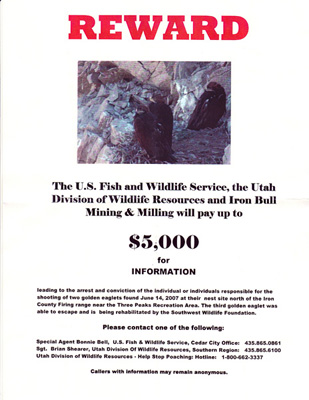
Poster credit goes to the U.S. Fish & Wildlife Service.
A reward poster has been widely distributed to help gather information that leads to the arrest and conviction of the individual or individuals responsible for the shooting of two golden eaglets on June 14, 2007.
Golden eagles are protected by both federal and state law. Violation of the Bald and Golden Eagle Protection Act is a federal offense carrying a maximum penalty of $100,000 fine and one year in jail for the killing of an eagle. The U.S Fish and Wildlife Service and the Utah Division of Wildlife Resources initially offered up to $2,500 in reward money for information leading to the arrest and conviction of the person or people responsible for the shooting of two golden eaglets. The reward has now been raised to $5000.
As tragic as this incident was, there was a small window of hope. What happened to the eaglet that fell out of the nest? He was rescued by Martin Tyner from the bottom of an adjacent 100-foot-deep mining pit. Fortunately, he sustained no serious injuries, but he was too young to fly. He didn’t know how to catch his own food to survive in the wild. He needed to be cared for and taught these basic survival skills. He needed to be nurtured while he built up his strength. There was no way he could be left on his own near the nest in the hope that his mother or father would come back to care for him. As a licensed wildlife rehabilitator, Martin Tyner’s first job was to check the eaglet for injuries and to treat them. Care might have involved setting a broken bone, inserting subcutaneous IV’s (for hydration), or giving medication.
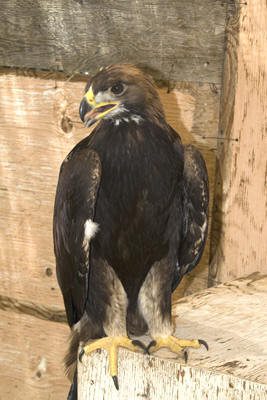
Copyright 2007 Noella Ballenger
This is the “Lone Survivor” several days after the shooting incident that took the lives of his two nest mates.
His next step was help the bird become healthy and strong. Bird patients are put into a flight facility where they can exercise. They’re given natural foods at first, but later, they’re allowed to catch their food. These steps are part of giving them time to heal and prepare for their release in the wild. All rescue and rehabilitation activities are supervised by various agencies to ensure that the animals receive top quality treatment and are returned to the wild as quickly as possible.
Recently, I had a call from Martin telling me that the little “Lone Survivor” was almost ready for release, and would I like to come up and photograph this very special moment? Oh, yes! I really wanted to photograph the release! It was scheduled to happen on August 18, 2007 to help commemorate the 75th anniversary of Cedar Breaks National Monument. There was no way that my friends or I would pass up the opportunity. It was a glorious day with the sun shining and a brisk breeze making the conditions for releasing the eagle absolutely perfect.
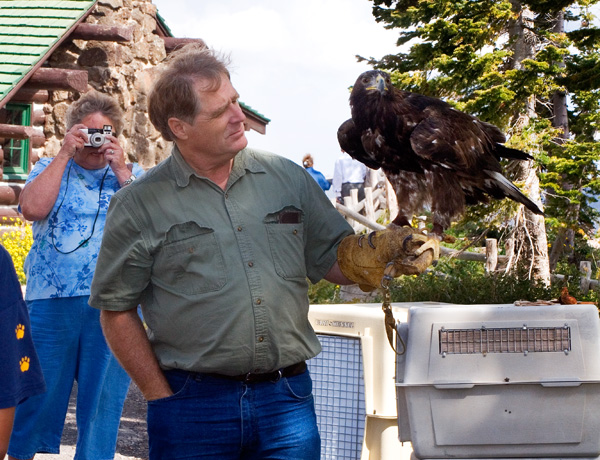
Copyright 2007 Noella Ballenger
It is important to learn about our wild creatures because one does not harm what is known and admired. Scout, Martin’s Golden Eagle, poses for visitors to Cedar Breaks National Monument.
Martin was there with his golden eagle Scout, the harris hawk Thumper, and a new peregrine falcon that’s being trained for his educational programs. He never misses a chance to share with others the uniqueness of the birds and allow visitors to learn more about protecting birds and animals in the wild.
Before long, it was time for Lone Survivor to be released. Over 250 people were in attendance as the Cedar Breaks Park Superintendent introduced special guests. Bonnie Bell, a Special Agent for the U.S. Fish and Wildlife Service, was introduced and spoke about the crime. Martin Tyner spoke about the eagle and Steve Cantonwine, the gentleman who would be releasing the eagle. “It is always wonderful to release a critter back to the wild where it belongs. I try whenever possible to find someone with a similar experience to do the release,” explained Martin.
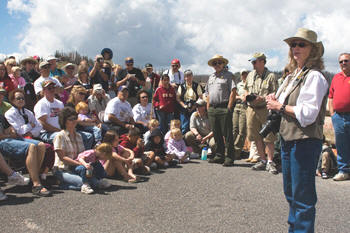
Copyright 2007 Noella Ballenger
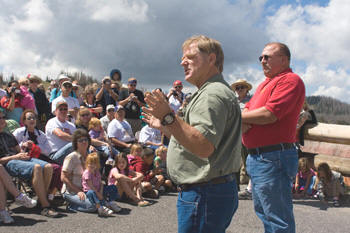
Copyright 2007 Noella Ballenger
Left: U. S. Fish and Wildlife Special Agent, Bonnie Bell, tells the crowd about the shooting of the Golden Eaglets.
Right: Martin Tyner introduces veteran Steve Cantonwine who survived Vietnam and two kinds of cancer caused by Agent Orange. Steve will be releasing the “Lone Survivor” back into the wild.
Steve Cantonwine is a former Marine who fought in Vietnam and got cancer from the defoliation chemical Agent Orange that was used in the war. As a survivor of both Vietnam and two kinds of cancer, he proudly undertook the honor of the special release, inviting all members in the audience who had ever served in our military to come to join him.
At last, the moment we had all been waiting for arrived. Martin carefully took Lone Survivor out of the cage and placed it against Mr. Cantonwine’s chest. Carefully holding the eagle’s legs, Mr. Cantonwine said, “I can’t tell you how good this feels. This is in honor of all of us here today and for those that aren’t able to be with us.” With that, the eagle was thrown up and out and took flight over the stunning Cedar Breaks National Monument accompanied by applause and shouts of encouragement. It was a breathtaking sight as we watched Lone Survivor soar off the edge of a 2,500 foot cliff.
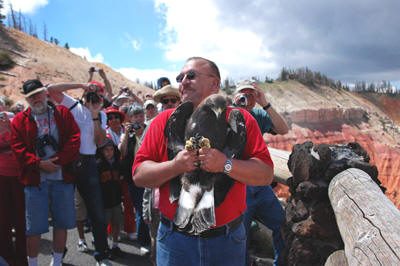
Copyright 2007 B. Bell
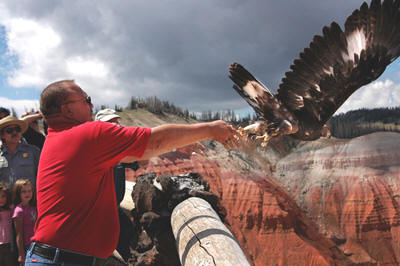
Copyright 2007 B. Bell Left:Steve Cantonwine holds the “Lone Survivor” and dedicates the release of this special bird “ …to those of us who are here today and to all of those who aren’t.”
Right: Steve Cantonwine releases the “Lone Survivor” back into the wild.
Lone Survivor looked back once as he flew away –perhaps in a sign of thanks–and then disappeared over the horizon. Perhaps Steve Cantonwine expressed the experience best when he said, “As a vet, this is the highest honor I’ve had. It was beautiful. He got his freedom and survived. He’ll do well.”
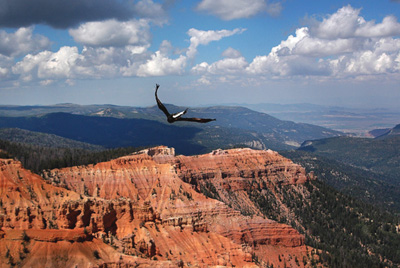
Copyright 2007 B. Bell
The Golden Eagle took to the air and soared over Cedar Breaks National Monument and out of sight.
Let’s touch the hearts of many, Marla@Apogee Photo Magazine
by Noella Ballenger

Leave a Reply